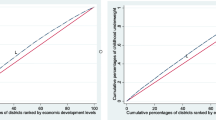Abstract
Objective: The aim of this study was to assess the economic difference in nutrition of under-five children.Methods: Bangladesh Demographic Health Survey data 1999–2000 were used for this study. In this study, quintiles were calculated on the basis of asset and wealth score by use of principal component analysis. To understand the nutrition status and health inequality concentration index was also calculated.Results: The ratio of poorest to the richest indicates that stunting and underweight of the rural under-five children was almost two times higher than that of the richest children. The negative concentration index shows that higher rate of malnutrition among the under-five children from the poorest class. This inequality in health situation of the children can be explained in terms of income inequality. In Bangladesh, about 40% wealth is concentrated to 10% of the families. The results are discussed in terms of policy consideration.Conclusion: It is expected that the findings will lead to consider alternative program strategies for the reduction of poor nutritional status of the children and their mothers
Similar content being viewed by others
References
Bangladesh Bureau of Statistics (BBS).Report of the Household Income and Expenditure Survey 2000. Dhaka: BBS, Statistics Division, Ministry of Planning, Government Republic of Bangladesh, 2003.
Ministry of Finance.Bangladesh Economic Review 2003. Dhaka: Planning Division, Ministry of Finance, Government of the People’s Republic of Bangladesh, 2003.
Sustainable Human Development Unit 2001.Analysis of Poverty Dynamics: An Integrated Approach. Technical Paper Series Number 5. Dhaka: Planning Commission, Government of the People’s Republic of Bangladesh, 2001.
Sen B.Inequalities in health in Bangladesh: A review of recent evidence. Paper presented in a workshop held on May 23–24’2001 organized by World Bank on talking a long term view, Dhaka: Health sector study, 2001.
Helen Keller International (HKI) and Institute of Public Health and Nutrition (IPHN).Nutrition and Health Surveillance in Rural Bangladesh. Nutritional Surveillance Project Bulletin No 2. Dhaka: HKI with IPHN, 2002
BBS and UNICEF.Child Nutrition Survey of Bangladesh 2000. Dhaka: BBS with UNICEF, 2002.
National Institute of Population Research and Training (NIPORT), Mitra and Associates (MA), and ORC Macro (ORCM).Bangladesh Demographic and Health Survey (BDHS), 1999–2000. Dhaka, Bangladesh and Calverton Maryland (USA): National Institute of Population Research and Training, Mitra and Associates and ORC Macro, 2001.
Wagstaff A. Poverty and health sector inequality.Bull of the World Health Organization 2002; 80 (2): 97–105.
Smith GD, Blame D, Bartley M. The black report on socioeconomic inequalities in health 10 years on.Br Med J 1990; 301: 373–377.
Marmot MG, Smith GD, Stanford S et al. Health Inequalities in among British civil servants: the Whitehall II study.Lancet 1991; 337: 1387–1393.
World Bank.World bank development indicators 2000. Washington DC: The World Bank, 2000.
Wagstaff A, Watanabe N. Socioeconomic inequality in child malnutrition in the developing world.Health and Population poverty, working paper no 2434. Washington DC: The World Bank, 2000.
Gwatkin DR., Ruston S, Johnson K, Paned RP, Wagstaff A.Socioeconomic differences in health, nutrition and population in Bangladesh. Washington DC; The World Bank, 2000. www.worldbank.org/hnp.
Filmier D, Pritchett L. Estimating wealth effects without expenditure data-or tears; with an application to educational enrollments in states of India.World Bank policy research working paper no 1994, Washington DC: The World Bank, 1998.
Wagstaff A, Pace P, Doorplate EV. On the measurement of inequalities in health.Social Science and Medicine 1991; 33: 545–557.
Kiwanis NC, Wagstaff A, Doorplate EV. Socioeconomic inequalities in health: Measurement, computation and statistical inference.Journal of Econometrics 1997; 77(1): 87–104.
Lambert P.The distribution and redistribution of income: A mathematical analysis. 2nded. Manchester: Manchester University Press, 1993.
Giashuddin MS, Kabir M, Rahman A, Hannan MA. Exclusive Breastfeeding and nutritional status in Bangladesh.Indian Journal of Pediatrics 2003; 70(6):471–475.
Author information
Authors and Affiliations
Corresponding author
Rights and permissions
About this article
Cite this article
Giashuddin, M.S., Kabir, M. & Hasan, M. Economic disparity and child nutrition in Bangladesh. Indian J Pediatr 72, 481–487 (2005). https://doi.org/10.1007/BF02724424
Issue Date:
DOI: https://doi.org/10.1007/BF02724424




